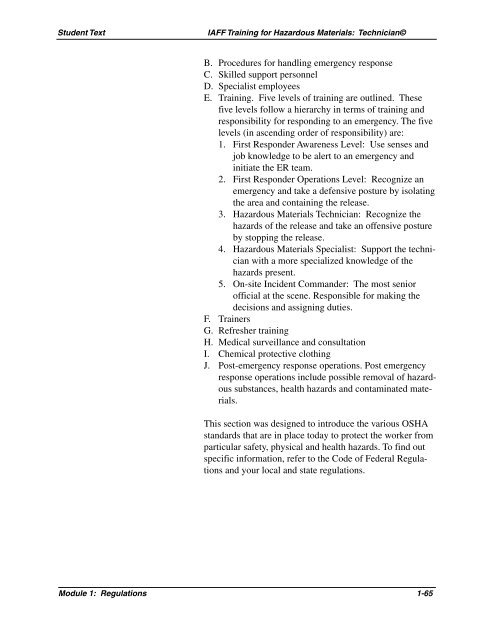Module 1: Regulations - International Association of Fire Fighters
Module 1: Regulations - International Association of Fire Fighters
Module 1: Regulations - International Association of Fire Fighters
You also want an ePaper? Increase the reach of your titles
YUMPU automatically turns print PDFs into web optimized ePapers that Google loves.
Student Text IAFF Training for Hazardous Materials: Technician©<br />
B. Procedures for handling emergency response<br />
C. Skilled support personnel<br />
D. Specialist employees<br />
E. Training. Five levels <strong>of</strong> training are outlined. These<br />
five levels follow a hierarchy in terms <strong>of</strong> training and<br />
responsibility for responding to an emergency. The five<br />
levels (in ascending order <strong>of</strong> responsibility) are:<br />
1. First Responder Awareness Level: Use senses and<br />
job knowledge to be alert to an emergency and<br />
initiate the ER team.<br />
2. First Responder Operations Level: Recognize an<br />
emergency and take a defensive posture by isolating<br />
the area and containing the release.<br />
3. Hazardous Materials Technician: Recognize the<br />
hazards <strong>of</strong> the release and take an <strong>of</strong>fensive posture<br />
by stopping the release.<br />
4. Hazardous Materials Specialist: Support the technician<br />
with a more specialized knowledge <strong>of</strong> the<br />
hazards present.<br />
5. On-site Incident Commander: The most senior<br />
<strong>of</strong>ficial at the scene. Responsible for making the<br />
decisions and assigning duties.<br />
F. Trainers<br />
G. Refresher training<br />
H. Medical surveillance and consultation<br />
I. Chemical protective clothing<br />
J. Post-emergency response operations. Post emergency<br />
response operations include possible removal <strong>of</strong> hazardous<br />
substances, health hazards and contaminated materials.<br />
This section was designed to introduce the various OSHA<br />
standards that are in place today to protect the worker from<br />
particular safety, physical and health hazards. To find out<br />
specific information, refer to the Code <strong>of</strong> Federal <strong>Regulations</strong><br />
and your local and state regulations.<br />
<strong>Module</strong> 1: <strong>Regulations</strong> 1-65
















